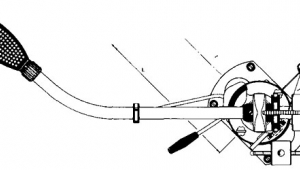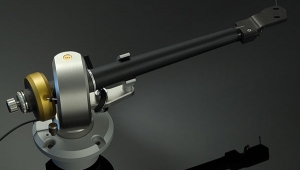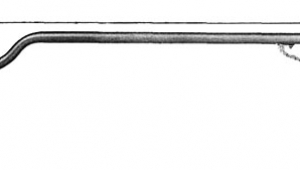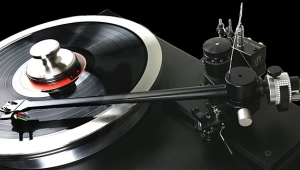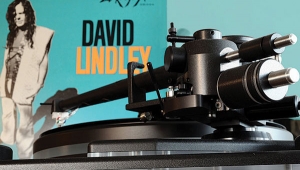| Columns Retired Columns & Blogs |
Graham Model 1.5 tonearm Page 4
Older unipivot arms, such as the Formula Four, used stable balance with the pivot point well above the center of gravity of the system. In contrast, the 1.5 places the pivot point in the vertical plane essentially at the center of gravity of the assembly, hence in neutral balance. The pivot point is in line with the longitudinal axis of the arm tube, main pivot housing, and counterweight. Two outrigger weights are positioned to either side of the pivot housing and slightly below the pivot point to provide lateral stability—otherwise the arm could tip over to one side or the other because it does not favor a particular rest position. The short lateral levers connecting the outriggers to the pivot housing create a strong stable balance along the line connecting them, thereby resisting torsional motion and keeping the arm in the correct upright position.
The outriggers manage to lower the center of gravity of the assembly—but only slightly in the vertical plane—and the arm operates essentially in neutral balance with minimal restoring forces. According to Bob, if the arm is lifted a full 0.5" off the record, the generated restoring force at the stylus tip is only about 30 milligrams. Because the outriggers are so close to the pivot point, their effect on the effective mass of the arm in the vertical plane is minimal. However, they account for most of the moving mass in the lateral plane.
These same outriggers are used to adjust the azimuth. The weights are moved in and out along threaded rods that provide a precise and stable adjustment. A closer look at these weights shows that they are displaced from true perpendicular in reference to the arm tube. This is by design, and assists in preventing the cartridge from twisting while negotiating record warps.
Much time and effort went into sorting out the counterweight design. Initially, rigidly coupled counterweight designs were investigated. This resulted in overemphasized bass that was representative of a high-Q tonearm/cartridge resonance. The bass was impressive, to be sure, but without the pitch definition and tightness of live music. According to Pramanik of B&O (see Audio, June 1980), a decoupled counterweight whose suspension is tuned to around the arm resonance offers a major advantage over fixed or stiffly suspended counterweights because the resonance peaks are much reduced in amplitude. Along these lines, a decoupled counterweight with a soft Sorbothane suspension was designed that gave a much more natural bottom end. This is something that Graham sweated over. He tells me that he was worried about the public mistaking a high-Q bass with its impression of slam and punch for real "killer" bass quality.
Although the arm tube of the 1.5 is visually less impressive than, say, that of the SME V, it is in fact extremely rigid and sonically inert. There's more here than meets the eye. The arm tube is made up of two concentric tubes. The outer tube is made of a magnesium/aluminum alloy, the inner of stainless steel and covered with bands of damping material. The inner tube also acts as a shield for the signal wires. The arm tube is heated to expand the damping material and bond it to the walls of both tubes. This results in true constrained layer damping of the arm wand.
The arm tube does not ring. Tapping it with a pencil results in nothing more than a well-muffled thud. The arm wand connects to the pivot assembly via a miniature Bendix "aerospace" connector that provides an extremely rigid mechanical connection. An additional wand amy be purchased with the idea of pre-mounting another cartridge for quick changeover. To use the patented Graham alignment fixture, it is necessary to separate the wand/cartridge shell from the rest of the arm. This makes it much easier to mount the cartridge in the headshell.
The signal cable connects to an external RCA jack box via a multi-pin connector. This means that you are free to use and experiment with your favorite interconnects between the arm and preamp. Tiffany and WBT jacks are available, the Tiffanys being standard. The latest Tiffany connectors using an OFC copper base with direct gold-plating (no intermediary plating surface)—the CM-4 OFC and CM-3 OFC—are also available at a premium. And that's what I used during the evaluation.
Installation
Along with the arm came a delightful array of tools designed to make your life much easier during the set-up and adjustment phase. There's a pair of "Uncle Bill's" tweezers for connecting the signal wires to the cartridge. Of course, there's a miniature Xcelite flat-blade screwdriver for tightening the cartridge screws, and plenty of screws to choose from. An Edmund Scientific Co. dual-power magnifier is available for use with the alignment fixture to be described shortly. The base mounting screws, the counterweight adapter screws, and all routine locking adjustments are made with a 7/64 Bondhus hex driver. With the single adjustment of the cueing-device height, no other adjustment is necessary. The rule is: "if the Bondhus adjustment tool doesn't fit it, don't try to adjust it."
Once the base assembly is securely mounted to the arm board, the next step is to fix the pivot-to-stylus distance. A spindle pin is slipped over the spindle of the 'table and the overhang adjustment is loosened with (of course) the Bondhus tool. The wand/headshell is moved via a micrometer until the spindle pin snaps into position in the outermost hole in the headshell, at which time you lock the overhang adjustment. There's no guesswork or awkward templates involved. Next, remove the arm wand and mount the cartridge in the headshell. The alignment fixture snaps into the top of the headshell and the rotating target plate is placed over the stylus. The target plate exerts about 1.5gm of force on the cantilever suspension to displace the moving assembly into its effective transducing location.
- Log in or register to post comments


